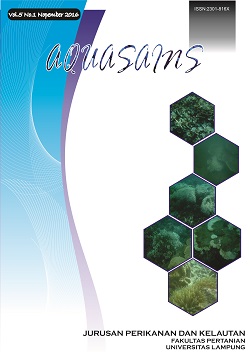PATHOGENICITY AND IN VIVO STUDY OF LOCAL ISOLATE Bacillus sp. D2.2 AT THE VANNAMEI CULTURE (Litopenaeus vannamei)
Abstract
Penggunaan bakteri biokontrol dapat dijadikan solusi bagi permasalahan pemberantasan penyakit untuk menekan pertumbuhan bakteri pathogen pada budidaya udang vaname (Litopenaeus vannamei). Bacillus sp. D2.2 merupakan isolat bakteri lokal yang terbukti mampu menghambat pertumbuhan Vibrio harveyi secara in vitro. Potensi lain isolat bakteri ini perlu diketahui lebih lanjut melalui penelitian ini. Tujuan penelitian ini adalah untuk mengetahui tingkat patogenisitas bakteri biokontrol Bacillus sp. D2.2 terhadap udang vaname dan kemampuannya dalam menghambat pertumbuhan bakteri patogen Vibrio alginolyticus secara in vivo. Uji patogenisitas Bacillus sp. D2.2 dilakukan dengan metode LD50 pada tingkat kepadatan 103, 104, 105 dan 106 CFU/ml.Hasil LD50 menunjukkan Bacillus sp. D2.2 tidak bersifat patogen karena tidak ada konsentrasi bakteri yang mematikan hingga 50% larva udang vaname. Uji antagonisme Bacillus sp. D2.2 terhadap V.alginolyticus secara in vivo dilakukan pada 2 perlakuan, yaitu pemeliharaan udang vaname tanpa penambahan Bacillus sp. D2.2 dan pemeliharaan udang vaname dengan penambahan Bacillus sp. D2.2. Kedua perlakuan diuji tantang dengan V.alginolyticus 105 cfu/ml dan diulang 3 kali. Hasil penelitian menunjukkan Bacillus sp. D2.2 mampu menurunkan pertumbuhan V.alginolyticus dari 105 CFU/ml sampai 103 CFU/ml. Hal tersebut menjelaskan bahwa Bacillus sp. D2.2 berpotensi sebagai bakteri biokontrol.
Downloads
Downloads
Published
How to Cite
Issue
Section
License
License for Authors
Authors who publish with this journal agree to the following terms:
- Authors retain copyright and grant the journal right of first publication with the work simultaneously licensed under a Creative Commons Attribution License that allows others to share the work with an acknowledgement of the work's authorship and initial publication in this journal.
- Authors are able to enter into separate, additional contractual arrangements for the non-exclusive distribution of the journal's published version of the work (e.g., post it to an institutional repository or publish it in a book), with an acknowledgement of its initial publication in this journal.
- When the article is accepted for publication, its copyright is transferred to Aquasains Journal. The copyright transfer convers the exclusive right to reproduce and distribute the article, including offprint, translation, photographic reproduction, microfilm, electronic material, (offline or online) or any other reproduction of similar nature.
- Authors are permitted and encouraged to post their work online (e.g., in institutional repositories or on their website) prior to and during the submission process, as it can lead to productive exchanges, as well as earlier and greater citation of published work (See The Effect of Open Access).
- The Author warrant that this article is original and that the author has full power to publish. The author sign for and accepts responsibility for releasing this material on behalf os any and all-author. If the article based on or part os student’s thesis, the student needs to sign as his/her agreement that his/her works is going published.
License for Regular Users
Other regular users who want to cite, distribute, remix, tweak, and build upon author’s works, even for commercial purposes, should acknowledge the work’s authorship and initial publication in this journal, licensed under a Creative Commons Attribution License.
This license lets others distribute, remix, tweak, and build upon your work, even commercially, as long as they credit you for the original creation.
This work is licensed under a Creative Commons Attribution 4.0 International License.Copyright Transfer Statement can be downloaded here


.png)









